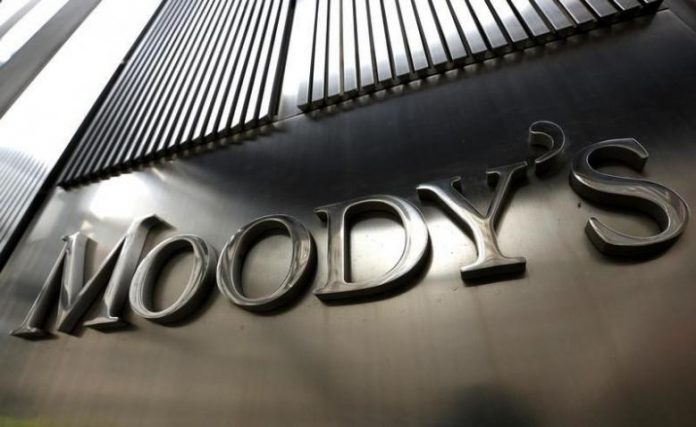KARACHI: Moody’s Investors Service (Moody’s) has placed the government of Pakistan’s local and foreign currency long term issuer and senior unsecured B3 ratings under review for downgrade. This comes as a result of the growing expectation regarding the government requesting bilateral sector debt service relief under the recently announced G20 initiative.
Moody’s has placed the B3 foreign currency senior unsecured ratings for the Third Pakistan International Sukuk Co Ltd under review for downgrade. The associated payment obligations are, in Moody’s view, direct obligations of the Government of Pakistan.
Pakistan’s Ba3 local currency bond and deposit ceilings remain unchanged. The B2 foreign currency bond ceiling and the Caa1 foreign currency deposit ceiling are also unchanged. The short-term foreign currency bond and deposit ceilings remain unchanged at Not-Prime. These ceilings act as a cap on the ratings that can be assigned to the obligations of other entities domiciled in the country.
The rating would likely be confirmed at its current level should Moody’s conclude that participation in bilateral official sector debt service relief would unlikely entail default on private sector debt or, if it would, that any losses experienced would likely be minimal.
WHY IS THERE A POSSIBILITY OF A DOWNGRADE
A key reason behind the initiative for a downgrade is the likelihood of Pakistan requesting bilateral debt service relief from G20 creditors following the recently announced initiative. This, as a result, will result in losses to private-sector creditors.
Due to the spread of COVID-19 and the subsequent impact the lockdown has on the economy, the government has been in the search of relief with regards to its debt. However, while such relief would help the government with fiscal expenditure, the suspension of debt service obligations would weigh negatively on rating.
The G20 has, however, called on private-sector creditors to participate in the initiative on comparable items. This suggests that, for the countries that elect to seek official sector debt service relief, the initiative may also lead to the suspension of payments or renegotiation of private sector debt service obligations.
the review period will allow the rating agency to assess whether Pakistan’s participation in the initiative will likely entail default on private sector debt, notwithstanding the intended voluntary nature of private sector participation and the fact that the country has not, to Moody’s knowledge, indicated an interest in extending the debt service relief request to the private sector; and, if so, whether any losses are expected to arise from that participation will be consistent with a lower rating.
Despite the repercussions of the slowdown in economic activity in Pakistan as a result of COVID-19, the ongoing reforms by the government, that point to the developing improvement in credit fundamentals prior to the outbreak, and financing from development partners contain the pressure on the sovereigns liquidity and external positions.
As per Moody’s assessment, the major impact of COVID-19 is on Pakistan’s economic growth which raises fiscal challenges and delays the government’s fiscal consolidation and debt reduction efforts. Moody’s expects Pakistan’s economy to contract by around 1% in fiscal 2020 (ending June 2020), and to grow by 2-3% in fiscal 2021 — below potential.
This, however, is being countered through effective use of monetary policy and technical support from development partners, in attempts to hamper the impact on sovereign liquidity and external positions.
Moody’s commented on the lack of trade integration and how Pakistan is a relatively closed economy.
The economic slowdown will weigh on government revenue and modestly raise spending, in turn pushing the fiscal deficit wider to close to 10% of GDP in fiscal 2020. As a result, Moody’s projects the government’s debt burden to reach around 85-90% of GDP in fiscal 2020.
However, the government’s commitment to fiscal reforms, including under its 2019-22 International Monetary Fund program, provides a crucial anchor for the continued expansion of its revenue base when economic activity gradually normalizes. Overall, Moody’s expects that the debt burden will return to a downward trend after the initial shock.
Moody’s projects the current account deficit to be relatively narrow, around 2% of GDP in this and the next fiscal year, as lower goods and oil imports offset a fall in remittances inflows.
IMPACT OF CLIMATE CHANGE
Moody’s commented on the seriousness of climate issues with regards to Pakistan by calling it vulnerable to climate change risk. Pakistan is significantly exposed to extreme weather events, including tropical cyclones, drought, floods, and extreme temperatures.
In particular, the magnitude and dispersion of seasonal monsoon rainfall influence agricultural sector growth and rural household consumption. The agricultural sector directly accounts for around 20pc of GDP and exports, and nearly 40pc of total employment. As a result, both droughts and floods can create economic, fiscal, and social costs for the sovereign.
Social considerations are material to Pakistan’s credit profile. Access to quality healthcare, education, and utilities such as electricity and water remains limited, especially in rural areas, although the government is addressing these issues as a key priority through its “Ehsaas” program that is aimed at reducing poverty and inequality, strengthening social safety nets and promoting human capital development. Moody’s regards the coronavirus outbreak as a social risk under its ESG framework, given the substantial implications for public health and safety. For Pakistan, the epidemic exposes the challenge to the government in enhancing healthcare and public services provision.
























